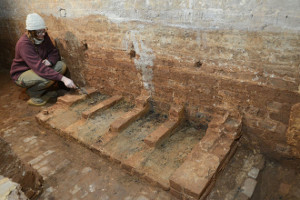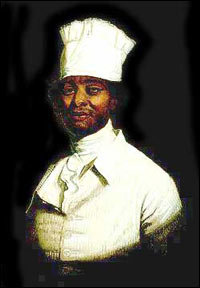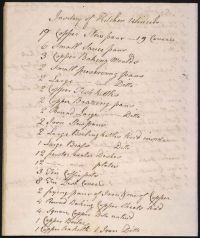|
Stoves of Jefferson Chef James Hemings Found
January 10, 2018
Archaeologists know a bit more about James Hemings, the enslaved head chef to Thomas Jefferson. Excavations underneath what had for many years been public toilets at Jefferson's Monticello homestead unearthed the remains of the kitchen used by Hemings to cook meals for Jefferson and his guests. The brick floor was largely intact; also remaining were remains of a fireplace and four stew stoves, a special kind of stove used to make food that needed slow heating. The dig was in the cellar of the first brick building built on the estate; Thomas Jefferson and Martha, his wife, lived in this building, called the South Pavilion, while the main estate was being built. Digging had not taken place in the cellar before because it had housed visitor bathrooms. The archaeologists also found many, many artifacts including toothbrushes, fragments of beads and glass bottles and ceramics, and animal bones. Jefferson first assumed ownership of Hemings in 1774, when the boy was 9. In that year, James Hemings and his brother Robert went to Monticello to work as slaves on Jefferson's property. James Hemings served in many capacities at Monticello, including duties as a messenger, driver, house servant, and chef. It was this last duty that brought him a limited amount of fame. Hemings was said to be the smartest among his family's 12 children, of whom the most famous was their sister Sally. James Hemings went with Jefferson to Richmond when the latter was elected governor in 1779. Jefferson trusted Hemings enough to lead Martha Jefferson away from Richmond during the Revolutionary War when the city was threatened in 1781 by British forces under Benedict Arnold. When Jefferson went to France as commerce minister to that country in 1784, Hemings went as well. He was 19. Although Hemings did not speak France, he arranged lodgings for Jefferson in the city of Rouen and then in Paris. Hemings became an apprentice to a caterer named Combeaux, who was responsible for making Jefferson's meals. Hemings also trained under a chef and a pastry chef at the Chateau de Chantilly, which has been referred to as the "five-star kitchen" of 18th-Century France. He learned the craft so well that in 1787, he was named chef de cuisine (head chef) at the Hotel de Langeac, where Jefferson was living. With the wages he received for this job, Hemings paid for some French language lessons. Jefferson and Hemings returned to Monticello in 1789 and then went the next year to New York and to Philadelphia; it was there that they stayed for a few years. During this time, Hemings managed the kitchen, cooked meals for Jefferson and family and guests, and also served as Jefferson's butler. Jefferson was quite fond of French food, before and after living in France, and Hemings served many French and French-inspired dishes at Jefferson's various homes. Among the innovations that would have been new to American palettes were creme brûlée, meringues, and Chantilly cream. Hemings it was who was chef and kitchen manager on June 20, 1790, when Jefferson played dinner host to his bitter political rival Alexander Hamilton; after that long dinner and discussion, they came to an agreement that included a plan to finance the debt from the Revolutionary War and a decision to install the capital of the new nation along the Potomac River. Hemings had an opportunity to escape in France but did not take it. He stayed with Jefferson, enslaved but able to save money and tasked with many responsibilities, until 1796, when Jefferson freed him. Hemings left Monticello in February of that year, leaving behind a handwritten inventory of kitchen utensils. Not much else is known of Hemings's life. Jefferson, after being elected President in 1800, asked him to be the head chief at the President's House; Hemings refused. In that same year, Hemings returned briefly to Monticello and was again kitchen manager for Jefferson while he was home on holiday. Hemings left in September and died a month later. In addition to the utensil inventory, he left behind four recipes, including one for Snow Eggs. |
Social Studies for Kids |
Social Studies for Kids
copyright 2002–2019
David White







